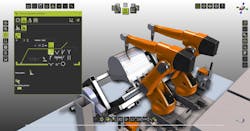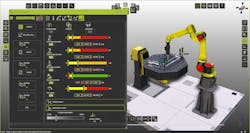FASTSUITE E2 AI-Based Robot Simulation Tool, Release 2023.2
FASTSUITE E2, the 3D simulation software, features 28 new functions and enhancements as well as three major highlights in its latest release: 2023.2.
The 3 major additions are automated AI-based path optimization, automated seam searches, plus easy planning of welding operations via the Weld Cockpit.
The new release focuses on 3 specific technology bundles:
- Efficient planning of welding paths
- AI-based offline programming (OLP) and automatic path optimization
- Sensor functions for seam identification and seam tracing
Offline Programming (OLP) with automated path optimization offers manufacturers a leg up in the autonomous programming of robot welding operations. The function relies on AI algorithms to automatically generate robot paths and analyze them to identify issues like collisions, axis limits, singularities, etc. The algorithm then searches for optimal solutions and automatically generates error-free programs.
Optimized paths mean that the robots move more smoothly and efficiently during their welding operations, which shortens overall cycle times.
Automatic seam identification and tracing enable automated generation and optimization of robot welding paths. The robot programs are able to self-adjust to account for geometry deviations within the components and tacking arrangements, again reducing the need for manual reworking of the robot cell.
The Weld Cockpit enables precise and consistent planning of welding processes and ensures reliable, replicable results. The “cockpit lets the user insert welding symbols to define the intended welding path or transfer a welding path directly from a 3D master model. It also supports the standardized transfer of tooling information from production drawings to OLP processes.
Standardization and the use of recognized welding symbols and standards make the Cockpit a valuable aid in ensuring consistency and reliability. Automated parameter assignment produces uniform results and better quality because it largely eliminates human misinterpretation of welding symbols, errors in welding path definition, and incorrect assignment of process parameters.
- Minimizes downtime of production equipment and human resources
- Minimizes the costs and efforts of planning and setup of production equipment
- Eliminates risks and inaccuracies during factory planning and production ramp-up
- Shortens the time-to-production
- Easy-to-use
- Any data format compatibility
- For all robots and machines
- Consistent and scalable simulation model
- Connection with PLM and IoT platforms
- Technology-based offline programming
Packages:
Automation Engineer:
- Production-system validation: Controller communication, sensor communication, system behavior
- Robot/machine programming & validation
- Cycle time validation
- Minimization of the real commissioning time
- Project completion on schedule
- Identifying risks early on
Offline Programmer:
- Robot/machine programming & validation: Motion, Process/technology, Logic
- Automatic collision detection & automatic path creation
- Upload robot programs from production (reverse engineering)
- Support for robotic and machining complex technologies
- Cycle time validation, connection to real controls (SIL, HIL)
- Technology packages to maximize system reliability
Concept Planner:
- Creation and modification of 3D layouts
- Drag & Snap functions to position resources and to connect resources geometrically and logically
- Validation of the layout: reachability, working spaces
- CAD Import Export
System Integrator:
- From layout creation to OLP and PLC validation
- Connecting robotics, CNC, and PLC in a simulation model
- Customer communication: 3D pdf, reports
- Open standards, such as STEP and AML import for CAD data and simulation resources
- XML-based import structures for process planning information
- Seamless data exchange with project partners
CENIT North America, Inc.

